Lead poisoning is a serious health concern, especially for young children whose bodies and minds are still developing. Exposure to lead can have long-lasting negative consequences, including:
- Learning and behavior problems: Difficulty concentrating, hyperactivity, and decreased IQ.
- Developmental delays: Growth problems and delayed speech and language development.
- Hearing and vision problems: Lead exposure can even impact a child’s hearing and vision.
Unfortunately, lead is still present in our environment, and in Connecticut, this is of particular concern. Around 70% of the state’s housing stock was built before 1980, and lead paint was commonly used in homes constructed prior to 1978. This means the potential for lead exposure exists in many homes across Connecticut.
The only way to know if your child has been exposed to lead is through a blood test administered by a healthcare provider. Thankfully, Connecticut has taken a crucial step by mandating universal blood lead screening. This means all children in the state are required to be tested at least twice between the ages of 9 months and 35 months.
However, while this initial screening is crucial, only about 60% of children in Connecticut receive the recommended two tests before the age of 3. This is concerning because lead exposure can occur at any time during this critical developmental window.
Here’s what you can do to protect your child:
- Know your home’s history. If your home was built before 1978, consider getting it tested for lead paint. You can find resources and information on lead testing at https://portal.ct.gov/dph/Environmental-Health/Lead-Poisoning-Prevention-and-Control/Lead-Poisoning-Prevention-and-Control-Program.
- Schedule regular blood lead tests for your child. Talk to your pediatrician about getting your child tested at the recommended intervals, even if you don’t suspect lead exposure.
- Be aware of potential sources of lead exposure. While lead paint is the most common source, lead can also be found in soil, dust, and even some imported toys, foods, and products.
By taking these steps, we can work together to protect our children from the dangers of lead poisoning and ensure they have the healthy environment they need to thrive. Let’s make sure every child in Connecticut has the opportunity for a healthy start in life.


